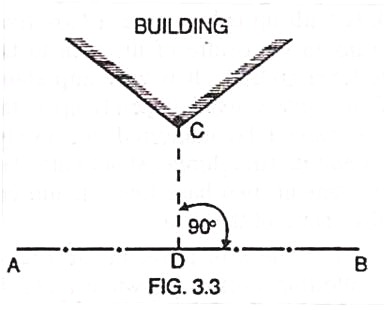The offsets are classified according to direction and length, according to direction it is of two types i.e., perpendicular offsets and oblique offsets, according to length i.e., short offsets and long offsets.
1. According to Direction:
(i) Perpendicular offsets, and
(ii) Oblique offsets.
(i) Perpendicular Offsets:
ADVERTISEMENTS:
The distances measured at right angles to the chain line from the objects are known as perpendicular or rectangular or right offsets such as CD (Fig. 3.3.) Usually the offsets are perpendicular offsets. In the strict sense, an offset means a perpendicular offset.
(ii) Oblique Offsets:
ADVERTISEMENTS:
All offsets which are not at right angles to the main survey lines are known as oblique or tie line offsets such as CD and CE (Fig. 3.4.) When the object to be plotted is at a long distance apart from the chain line or it is an important one such as a corner of a building, oblique offsets are taken. These are also taken to check the accuracy of right angled offsets and to locate the position of stations in various surveys. Sometimes they help in reducing the number of main survey lines.
2. According to the Length:
(i) Short offsets and
(ii) Long offsets.
ADVERTISEMENTS:
Generally the offsets are called short when they are less than 15 m in length and long when their length exceeds 15 m.
The Offsets should as far as possible be short ones as they are less liable to be erroneous due to incorrect length of tape or incorrect direction than if they are long. Also short offsets can be measured more quickly and accurately than long ones. Tie lines should be drawn to avoid long offsets.

